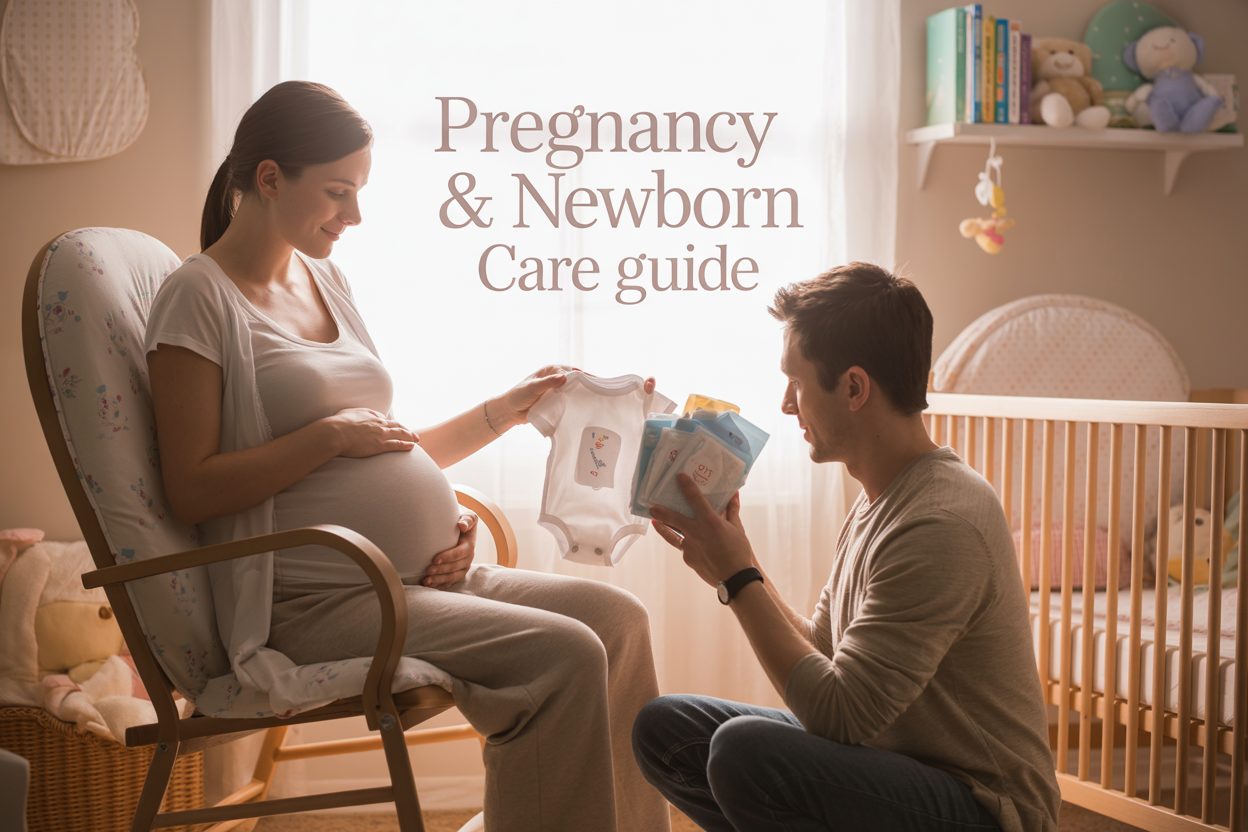Expecting your first baby brings excitement mixed with countless questions about what lies ahead. This pregnancy guide for new parents offers reassuring support for first-time parents ready to embrace this life-changing journey with confidence.
Who this guide helps: New and expecting parents who want practical advice without overwhelming medical jargon—real guidance you can actually use during pregnancy and those precious early weeks with your newborn.
You’ll discover how to handle pregnancy physical changes that catch many parents off guard, from morning sickness to those final uncomfortable weeks. We’ll walk through newborn care tips that make those first days less scary, including newborn feeding basics that work for real families. Plus, you’ll learn why postpartum self care isn’t selfish—it’s essential for being the parent your baby needs.
Ready to feel more prepared? Let’s dive into the practical stuff that actually matters when you’re growing and caring for your little one.
Essential Pregnancy Preparation for Expecting Parents

Creating a Safe and Nurturing Environment Before Baby Arrives
Your home will soon become your baby’s first world, so making it safe and welcoming should be a top priority. Start by baby-proofing essential areas, even though your little one won’t be crawling for months. Install safety latches on cabinets, cover electrical outlets, and secure heavy furniture to walls. These preparations help you get comfortable with safety measures before they become critical.
The nursery deserves special attention when following your pregnancy guide for new parents. Choose a crib that meets current safety standards, ensuring slats are no more than 2⅜ inches apart. Skip the bumper pads, pillows, and loose blankets – these increase SIDS risk. A firm mattress with a fitted sheet is all your newborn needs for safe sleep.
Consider air quality and temperature control. A room thermometer helps maintain the ideal 68-70°F range, while an air purifier can reduce allergens. Blackout curtains promote better sleep patterns from the start.
Don’t forget about creating peaceful spaces throughout your home. Designate quiet corners for feeding and bonding, complete with comfortable seating and soft lighting. Stock these areas with essentials like burp cloths, water bottles, and phone chargers – you’ll appreciate having everything within reach during those long feeding sessions.
Building Your Support Network for Pregnancy and Beyond
Expecting parents preparation should include assembling your personal support team well before delivery day arrives. This network becomes your lifeline during challenging moments and celebrates your victories along the way.
Start with family members who genuinely want to help. Have honest conversations about your expectations and their availability. Some relatives excel at meal preparation, others at household tasks, and some simply provide emotional support through listening. Identify each person’s strengths and communicate your needs clearly.
Professional support proves invaluable for first-time parents. Your healthcare provider, lactation consultant, and pediatrician form your medical foundation. Consider adding a postpartum doula if your budget allows – these trained professionals offer practical help with baby care and emotional support during your recovery.
Parent groups, both online and in-person, connect you with others sharing similar experiences. Local hospitals often host new parent classes where lasting friendships develop. Online communities provide 24/7 support when questions arise at 3 AM.
Pregnancy emotional support also includes preparing your partner for their new role. Attend prenatal classes together, discuss parenting philosophies, and practice baby care techniques. Consider couples counseling if communication challenges arise – pregnancy brings significant changes that benefit from professional guidance.
Create backup plans for different scenarios. Identify multiple people who can drive you to the hospital, care for pets, or handle work responsibilities when labor begins unexpectedly.
Understanding Prenatal Care and Regular Check-ups
Prenatal care forms the foundation of a healthy pregnancy and successful delivery. Your first appointment typically occurs around 8-10 weeks, establishing baseline measurements and screening for potential complications. These visits monitor both your health and your baby’s development throughout pregnancy.
Early appointments focus on confirming pregnancy, calculating due dates, and reviewing medical history. Your provider will order blood tests checking for anemia, infections, and genetic markers. Urine tests become routine, screening for protein, bacteria, and glucose levels that indicate various conditions.
The appointment schedule intensifies as pregnancy progresses. Monthly visits during the first two trimesters increase to bi-weekly, then weekly as your due date approaches. Each visit includes weight checks, blood pressure monitoring, and measuring fundal height to track baby’s growth.
Ultrasounds provide exciting glimpses of your developing baby while serving important medical purposes. The first-trimester scan confirms heartbeat and proper implantation. The 20-week anatomy scan examines organ development and can reveal your baby’s sex if desired.
Blood pressure monitoring becomes increasingly important as pregnancy advances. Elevated readings can indicate preeclampsia, a serious condition requiring immediate attention. Your provider will teach you warning signs like severe headaches, vision changes, and upper abdominal pain.
Don’t hesitate to contact your healthcare team between appointments with questions or concerns. Most practices offer nurse hotlines for non-emergency issues, helping you distinguish between normal pregnancy symptoms and situations requiring medical attention.
Planning for Labor and Delivery Options
Labor and delivery planning empowers you to make informed decisions about your birth experience while remaining flexible for unexpected developments. Understanding your options helps reduce anxiety and builds confidence as your due date approaches.
Hospital births offer comprehensive medical facilities and immediate access to interventions if complications arise. Tour your chosen facility beforehand, learning about their policies regarding visitors, pain management, and newborn procedures. Ask about amenities like birthing balls, showers, and rooming-in options that support natural labor progression.
Birth centers provide a middle ground between hospital and home births, offering a more relaxed environment while maintaining medical safety standards. These facilities typically support natural births with minimal interventions, though they maintain relationships with nearby hospitals for emergency transfers.
Pain management options deserve thorough discussion with your healthcare team. Epidurals remain popular for their effectiveness, though they can slow labor progression and increase intervention likelihood. Natural pain relief techniques include breathing exercises, position changes, water therapy, and massage. Many parents combine multiple approaches based on their comfort level and labor progression.
Creating a birth plan helps communicate your preferences while acknowledging that flexibility remains essential. Include your desires for pain management, labor positions, delayed cord clamping, and immediate skin-to-skin contact. Discuss scenarios where medical interventions might become necessary and your preferences for each situation.
Pack your hospital bag by 35 weeks, including comfortable clothing for labor, going-home outfits for both you and baby, toiletries, phone chargers, and important documents. Consider packing snacks for your support person and camera equipment for capturing precious first moments.
Prepare for postpartum recovery by arranging help at home, stocking comfortable nursing clothes, and setting up feeding stations. Your first time parent advice includes accepting that recovery takes time and asking for help when needed.
Navigating Physical and Emotional Changes During Pregnancy

Managing Common Pregnancy Symptoms and Discomforts
Morning sickness affects up to 80% of pregnant women, typically starting around the 6th week and easing by the second trimester. Combat nausea by eating small, frequent meals every two hours and keeping plain crackers by your bedside. Ginger tea, vitamin B6 supplements (with your doctor’s approval), and avoiding strong odors can provide significant relief.
Fatigue hits hardest during the first and third trimesters as your body works overtime to support your growing baby. Listen to your body’s signals and rest when needed. Power naps of 20-30 minutes can boost energy levels without disrupting nighttime sleep patterns.
Heartburn becomes more common as pregnancy progresses and your growing uterus pushes against your stomach. Eat smaller portions, avoid spicy or acidic foods, and stay upright for at least an hour after meals. Sleeping with your head elevated can prevent nighttime discomfort.
Swelling in feet, ankles, and hands is normal but can be uncomfortable. Elevate your feet whenever possible, wear comfortable shoes, stay hydrated, and reduce sodium intake. Contact your healthcare provider if swelling occurs suddenly or is accompanied by severe headaches.
Back pain affects most pregnant women as your center of gravity shifts. Prenatal yoga, warm baths, and proper posture can provide relief. A maternity support belt may help distribute weight more evenly.
Maintaining Mental Health and Emotional Well-being
Pregnancy emotional support becomes crucial as hormonal fluctuations create mood swings that can catch you off guard. These feelings are completely normal and experienced by most expectant mothers. Creating a support network of family, friends, and other pregnant women provides emotional anchoring during this transformative time.
Anxiety about becoming a parent is universal among expecting parents preparation. Write down your concerns and discuss them with your partner or healthcare provider. Many worries stem from the unknown, so attending parenting classes and reading reliable resources can build confidence.
Depression during pregnancy affects 10-20% of women and shouldn’t be dismissed as typical mood changes. Warning signs include persistent sadness lasting more than two weeks, loss of interest in activities you once enjoyed, difficulty sleeping or concentrating, and feelings of worthlessness. Professional help is available and safe during pregnancy.
Stress management techniques play a vital role in emotional well-being:
- Deep breathing exercises (try the 4-7-8 technique)
- Meditation apps designed for pregnancy
- Journaling to process changing emotions
- Regular communication with your partner about fears and expectations
Consider joining pregnancy support groups where you can connect with other expectant mothers facing similar experiences. Online communities also provide 24/7 access to advice and encouragement.
Professional counseling offers valuable support if you’re experiencing relationship stress, work pressures, or family conflicts during pregnancy. Many therapists specialize in perinatal mental health and understand the unique challenges of this life stage.
Safe Exercise and Nutrition Guidelines for Expectant Mothers
Regular physical activity during pregnancy reduces the risk of gestational diabetes, excessive weight gain, and delivery complications. The American College of Obstetricians and Gynecologists recommends 150 minutes of moderate exercise weekly for healthy pregnant women.
Safe pregnancy exercises include:
- Walking (ideal for all fitness levels)
- Swimming (excellent for joint support)
- Prenatal yoga (improves flexibility and reduces stress)
- Low-impact aerobics
- Stationary cycling
- Modified strength training with lighter weights
Avoid these activities:
- Contact sports (soccer, basketball)
- Activities with fall risks (skiing, horseback riding)
- Scuba diving
- Hot yoga or exercising in high temperatures
- Exercises lying flat on your back after the first trimester
Nutrition guidelines focus on quality over quantity. You only need an extra 300 calories daily during the second and third trimesters – roughly equivalent to a peanut butter sandwich.
Essential nutrients include:
- Folic acid (400-800 mcg daily) prevents neural tube defects
- Iron (27 mg daily) supports increased blood volume
- Calcium (1000 mg daily) builds baby’s bones and teeth
- DHA omega-3 fatty acids support brain development
- Protein (71 grams daily) aids tissue growth
Foods to emphasize:
- Leafy green vegetables
- Lean proteins (chicken, fish, beans)
- Whole grains
- Dairy products or calcium-rich alternatives
- Colorful fruits and vegetables
Foods to limit or avoid:
- High-mercury fish (shark, swordfish, king mackerel)
- Raw or undercooked meat, eggs, and seafood
- Unpasteurized dairy products
- Excessive caffeine (limit to 200mg daily)
- Alcohol (no safe amount established)
Stay hydrated with 8-10 glasses of water daily, especially if you’re exercising or experiencing morning sickness. Dehydration can worsen fatigue and contribute to constipation.
Preparing for Your Baby’s Arrival

Setting Up the Perfect Nursery on Any Budget
Creating a beautiful, functional nursery doesn’t require breaking the bank. Start with the essentials: a safe crib that meets current safety standards, a comfortable chair for feeding sessions, and adequate storage for baby clothes and supplies. You can find quality used furniture at consignment stores, online marketplaces, or through parent groups on social media.
Paint costs very little but transforms any space dramatically. Choose calming colors like soft blues, greens, or warm neutrals that work for any gender. DIY wall decals or simple artwork created by family members add personal touches without expensive price tags.
For lighting, a simple table lamp with a soft bulb works perfectly for nighttime feedings. Blackout curtains help establish healthy sleep patterns and can often be found at discount stores. Focus your budget on safety items like outlet covers, cabinet latches, and a reliable baby monitor rather than decorative elements.
Storage solutions don’t need to be expensive. Plastic bins, repurposed dresser drawers, and hanging organizers keep everything tidy. Remember, babies need very little space initially – a corner of your bedroom works just fine for the first few months.
Essential Baby Gear and Must-Have Items for Newborns
New parents often feel overwhelmed by endless baby product lists, but newborns actually need surprisingly few items. Your baby arrival checklist should prioritize safety, feeding, and basic comfort over trendy gadgets.
Feeding Essentials:
- Bottles and nipples (even if breastfeeding)
- Burp cloths (you’ll need many more than you think)
- High chair or feeding seat for later months
Diapering Basics:
- Newborn and size 1 diapers
- Wipes (sensitive skin formula)
- Diaper rash cream
- Changing pad with safety straps
Clothing Must-Haves:
- Onesies in newborn and 0-3 month sizes
- Sleep gowns for easy diaper changes
- Swaddle blankets or sleep sacks
- Weather-appropriate outerwear
Safety and Transport:
- Properly installed car seat (many hospitals won’t let you leave without one)
- Baby thermometer
- Infant nail clippers
Skip expensive items like wipe warmers, bottle sterilizers, or elaborate mobiles. Babies are perfectly happy with simple, safe basics that allow them to eat, sleep, and stay clean.
Understanding Hospital Bag Essentials for Labor
Pack your hospital bag by 36 weeks to avoid last-minute stress. Create separate bags for yourself, your partner, and baby to stay organized during the excitement of labor.
For Mom:
- Comfortable going-home outfit (pregnancy-sized)
- Several nursing bras and comfortable underwear
- Non-slip slippers and warm socks
- Personal toiletries and any special comfort items
- Phone charger and entertainment options
- Copies of important documents and insurance cards
For Baby:
- Going-home outfit in newborn and 0-3 month sizes
- Weather-appropriate blanket
- Car seat (properly installed before leaving)
For Partner:
- Change of clothes and toiletries
- Snacks and drinks
- Camera or phone for photos
- List of people to contact after birth
Most hospitals provide basic necessities like diapers, blankets, and initial baby clothes, so don’t overpack. Focus on comfort items and anything that makes you feel more at home. Many parents find that having their own pillow (in a colored pillowcase) makes a big difference in comfort levels.
Creating a Birth Plan That Works for Your Family
A birth plan helps communicate your preferences to your healthcare team, but flexibility remains key since labor rarely follows a script. Think of it as your wish list rather than a rigid contract.
Pain Management Preferences:
- Natural pain relief methods you’d like to try
- Your feelings about epidurals or other medical pain relief
- Positions you prefer for labor and delivery
Labor Environment:
- Who you want present during delivery
- Music, lighting, or aromatherapy preferences
- Whether you want immediate skin-to-skin contact
Medical Interventions:
- Your preferences regarding episiotomies, vacuum delivery, or cesarean sections
- Feelings about labor augmentation methods
- Cord blood banking decisions
Postpartum Preferences:
- Breastfeeding goals and any feeding preferences
- Newborn procedures like eye ointment or vitamin K shots
- Rooming-in preferences
Share your plan with your healthcare provider well before your due date. Discuss any concerns or questions, and remember that medical emergencies sometimes require quick changes to plans. The most important goal is a healthy delivery for both you and your baby.
Choosing Healthcare Providers for Your Baby
Selecting your baby’s healthcare provider before birth gives you one less thing to worry about after delivery. Most parents choose between pediatricians and family doctors, each offering different advantages.
Pediatricians specialize exclusively in children’s health and development. They’re experts in childhood illnesses, developmental milestones, and age-specific concerns. However, this means separate appointments for family members.
Family Doctors can care for your entire family, making scheduling easier and ensuring continuity of care. They understand family health patterns and can coordinate care between family members when needed.
Questions to Ask Potential Providers:
- What are their philosophies on common parenting decisions like sleep training or feeding?
- How do they handle after-hours concerns and emergencies?
- What hospital privileges do they have?
- How far in advance do you need to schedule well-child visits?
- Do they support your feeding choices (breastfeeding, formula, or combination)?
Schedule meet-and-greet appointments during your third trimester. Trust your instincts about communication style and whether you feel comfortable asking questions. Your baby’s first appointment typically happens within 2-3 days after hospital discharge, so having this relationship established beforehand reduces stress during those early newborn care days.
Consider location and office hours that work with your schedule. Some practices offer weekend or evening hours, which can be helpful for working parents. Check if they use patient portals for communication and prescription refills, as these tools become invaluable for busy parents.
Mastering Newborn Care Fundamentals

Feeding Your Baby with Confidence
Getting the hang of feeding your newborn feels overwhelming at first, but trust yourself – you’ve got this. Whether you choose breastfeeding, bottle feeding, or a combination of both, the most important thing is keeping your baby well-fed and growing.
Breastfeeding Basics
Your body knows what it’s doing, even when you don’t feel like it. Most babies want to eat 8-12 times per day in those early weeks. Watch for hunger cues like rooting, lip smacking, or hand-to-mouth movements rather than waiting for crying – that’s actually a late hunger sign.
Position matters more than you might think. Try the cradle hold, cross-cradle, or football hold to find what works best for both of you. Make sure your baby’s mouth covers most of your areola, not just the nipple. If it hurts beyond the first few seconds of latching, something needs adjusting.
Bottle Feeding Success
Formula feeding gives you flexibility and lets partners share feeding duties. Follow your pediatrician’s guidance on formula type and preparation. Always use the exact water-to-powder ratio on the package – your baby’s kidneys depend on getting the right concentration.
Hold your baby semi-upright during feeds and tilt the bottle so milk fills the nipple completely. This prevents excess air intake that leads to uncomfortable gas. Let your baby set the pace rather than pushing them to finish every drop.
Reading Your Baby’s Signals
Full babies often turn their heads away, push the bottle or breast away, or simply fall asleep. Don’t force extra food – newborns have tiny stomachs and know when they’ve had enough. Wet diapers and steady weight gain tell you feeding is going well.
Establishing Healthy Sleep Patterns from Day One
Sleep deprivation hits new parents hard, but understanding newborn sleep helps you navigate those exhausting early months. Your baby’s sleep patterns will evolve quickly, and small steps now create better habits later.
Newborn Sleep Reality
Forget everything you thought you knew about sleep schedules. Newborns sleep 14-17 hours per day but in 2-4 hour stretches around the clock. Their tiny stomachs mean frequent feeding, which naturally disrupts longer sleep periods. This chaotic pattern typically lasts 6-8 weeks before things start settling down.
Creating a Sleep-Friendly Environment
Your baby spent nine months in a warm, dark, noisy womb, so recreate that comfort. Keep the nursery between 68-70°F and use blackout curtains for daytime naps. White noise machines or apps mask household sounds that might wake your little one.
Swaddling works wonders for many newborns because it mimics the snug feeling of the womb. Wrap your baby with arms down and legs slightly bent, but make sure hips can move freely. Stop swaddling once your baby starts trying to roll over.
Day and Night Differences
Help your baby learn when it’s time to be awake versus sleep time. During day feeds, keep lights bright, talk normally, and play gently. Night feeds should stay dim and quiet – change diapers only if necessary and avoid stimulating play.
Safe Sleep Practices
Always place your baby on their back to sleep, on a firm mattress with a fitted sheet. Keep the crib bare – no blankets, bumpers, pillows, or toys. Room-sharing without bed-sharing reduces SIDS risk while making night feeds easier.
Diaper Changing and Basic Hygiene Practices
Diaper duty becomes second nature faster than you’d expect, but having the right technique and supplies makes everything smoother. You’ll change roughly 10-12 diapers daily in those first weeks, so efficiency matters.
Setting Up Your Changing Station
Stock your changing area with everything within arm’s reach: diapers, wipes, diaper cream, clean clothes, and a small trash can. Never leave your baby unattended on a changing table – keep one hand on them at all times.
Step-by-Step Changing Process
Remove the dirty diaper but don’t immediately pull it away – let it catch any surprise sprays. Clean from front to back, especially for girls, using gentle wipes or warm washcloths. Pat the area completely dry before applying a thin layer of diaper cream to prevent rash.
When putting on the new diaper, the waistband should sit just below your baby’s belly button. You should be able to slip two fingers between the diaper and your baby’s skin – snug but not tight. The leg cuffs should tuck under rather than sticking out.
Recognizing and Preventing Diaper Rash
Red, irritated skin around the diaper area signals the start of diaper rash. Change wet or soiled diapers promptly, allow some diaper-free time for air drying, and use a zinc oxide barrier cream. Persistent or severe rashes need your pediatrician’s attention.
Bath Time Basics
Newborns don’t need daily baths – 2-3 times per week keeps them clean without drying their sensitive skin. Until the umbilical cord heals, stick to sponge baths. Use lukewarm water and mild, fragrance-free baby soap. Always support your baby’s head and neck, and never leave them alone in water, even for a second.
Clean your baby’s eyes with separate, damp cotton balls from inner to outer corner. Gently clean visible parts of ears with a washcloth – never use cotton swabs inside the ear canal.
Building Strong Bonds with Your Newborn

Understanding Your Baby’s Cues and Communication
Your newborn arrives equipped with their own unique language, and learning to decode these signals becomes one of your most valuable parenting skills. Early hunger cues include rooting movements, lip smacking, and bringing hands to mouth – catching these signs before crying begins makes feeding smoother for everyone. When babies are overstimulated, they might turn their heads away, arch their backs, or spread their fingers wide.
Sleep cues are equally important to recognize. Heavy eyelids, yawning, and decreased activity signal it’s time for rest. Some babies become fussy when tired, while others simply stare blankly or lose interest in toys and faces around them. Pay attention to your baby’s individual patterns – some prefer quiet environments when sleepy, while others find gentle movement soothing.
Different cries carry distinct meanings. The short, low-pitched cry often means hunger, while a more intense, higher-pitched wail might indicate pain or discomfort. Gas pain typically produces a rhythmic crying pattern, and overtired babies often have a whiny, continuous cry that can be challenging to soothe.
Watch body language too. Relaxed hands and smooth movements suggest contentment, while clenched fists and jerky motions often indicate stress or discomfort. Your baby’s eyes also communicate – bright, alert gazes show engagement, while glazed or unfocused looks suggest they need a break from stimulation.
Skin-to-Skin Contact and Its Incredible Benefits
Direct skin-to-skin contact creates magic between you and your baby that goes far beyond simple comfort. This practice, sometimes called kangaroo care, triggers powerful biological responses in both parent and child. When your baby lies against your bare chest, their heart rate stabilizes, breathing becomes more regular, and stress hormones decrease significantly.
For breastfeeding mothers, skin-to-skin contact stimulates milk production and helps establish successful nursing relationships. The physical closeness releases oxytocin, often called the “love hormone,” which strengthens maternal instincts and reduces postpartum depression risk. Partners who practice skin-to-skin also experience these hormonal benefits, creating strong paternal bonds from the earliest days.
Your baby’s temperature regulation improves dramatically through this contact. Your chest actually adjusts its temperature to match your baby’s needs – warming when they’re cool and cooling when they’re too warm. This natural thermostat works more effectively than blankets or clothing layers.
Make skin-to-skin a daily routine, not just a hospital experience. Aim for at least one hour each day, though even fifteen-minute sessions provide benefits. Remove your shirt and your baby’s diaper, then settle together with a blanket over both of you. Many parents find this practice especially helpful during fussy periods, as it often calms crying babies within minutes.
Both mothers and fathers should embrace this practice. Research shows that babies who receive regular skin-to-skin contact sleep better, cry less, and show improved brain development in areas related to emotional regulation and stress management.
Creating Daily Routines That Promote Connection
Meaningful connections happen through consistent, loving interactions woven throughout your day. Bath time becomes a special bonding opportunity when you speak softly, make gentle eye contact, and respond to your baby’s reactions to the warm water. Even diaper changes transform into connection moments when you narrate your actions, sing quietly, or play gentle peek-a-boo games.
Feeding times offer natural bonding opportunities regardless of whether you breastfeed or bottle-feed. Hold your baby close, maintain eye contact, and talk or hum softly. If bottle-feeding, switch sides occasionally to provide visual variety and encourage balanced development. Never prop bottles or multitask during feeds – this precious time builds trust and security.
Reading aloud, even to tiny newborns, creates positive associations with your voice and introduces language patterns. Choose books with high-contrast images or simple, rhythmic text. Your baby won’t understand words yet, but they absorb the cadence of language and connect it with comfort and attention from you.
Massage provides another powerful bonding tool that also supports your baby’s physical development. Use gentle strokes on arms, legs, and back while talking softly. Many babies find massage calming before bedtime, and it helps parents learn their baby’s body and responses to touch.
Create mini-rituals around daily activities. Always greet your baby enthusiastically after sleep, establish a special song for car rides, or develop a unique way of saying goodnight. These small traditions become cornerstones of your relationship and help your baby feel secure and loved.
Managing Visitor Guidelines and Protecting Family Time
Those first weeks home require careful balance between sharing your joy and protecting your family’s adjustment period. Well-meaning friends and relatives often want immediate access to your newborn, but your family needs time to establish routines and bond without external pressures or expectations.
Set visiting hours that work for your schedule, not others’ convenience. Many new parents find afternoon visits less disruptive than morning ones, when babies often cluster feed and parents feel most tired. Limit visit length to one or two hours maximum, and don’t hesitate to ask visitors to leave if you or your baby becomes overwhelmed.
Establish house rules before visitors arrive. Ask people to wash hands immediately upon entering, avoid strong perfumes or cigarette odors that might bother sensitive newborns, and respect your decisions about holding, feeding, or soothing your baby. If your baby is crying, visitors should understand that parents handle the situation rather than offering unsolicited advice or insisting on “helping.”
Phone ahead policies work well for many families. Require advance notice before visits, giving you opportunity to postpone if needed without awkward doorstep conversations when you’re exhausted or your baby is having a difficult day. Some parents designate specific days as visitor-free zones to ensure uninterrupted family time.
Consider appointing a family spokesperson who can update extended family and friends, reducing the number of phone calls and messages you need to handle personally. This person can also help coordinate meal deliveries or practical support while shielding you from social obligations during your adjustment period.
Remember that protecting family time isn’t selfish – it’s essential for healthy bonding and establishment of your confidence as new parents. Visitors will have many years to build relationships with your child, but these early bonding opportunities happen only once.
Caring for Yourself as a New Parent

Recovering from Childbirth and Healing Your Body
Your body has just accomplished something incredible, and now it needs time to heal. Recovery looks different for everyone, whether you had a vaginal delivery or C-section. The first six weeks are typically the most intense healing period, but some changes can last months or even longer.
Physical recovery involves managing pain, dealing with bleeding, and watching incisions heal if you had a cesarean. Your doctor will guide you through wound care, lifting restrictions, and when it’s safe to resume activities like driving and exercise. Don’t rush this process – your body worked hard for nine months and deserves patience during recovery.
Hormonal shifts play a huge role in how you feel physically and emotionally. Your milk production, sleep patterns, and energy levels are all affected by these changes. Some discomfort is normal, but severe pain, heavy bleeding, or signs of infection need immediate medical attention.
Accept help when it’s offered. Whether that’s someone bringing dinner, doing laundry, or watching the baby while you shower, saying yes helps you focus on healing. Remember that taking care of yourself isn’t selfish – it’s necessary for caring for your little one.
Managing Sleep Deprivation and Energy Levels
Sleep becomes a precious commodity with a newborn. Your baby’s sleep cycles don’t match yours, and frequent night feedings can leave you feeling exhausted. This phase is temporary, but it can feel overwhelming when you’re in the thick of it.
Sleep when the baby sleeps might sound cliché, but it’s solid advice. Even 20-30 minute naps can help reset your energy levels. Don’t worry about the dishes or laundry during these windows – rest should be your priority.
Create a support system for nighttime duties. If you’re breastfeeding, your partner can handle diaper changes and bring the baby to you. If you’re bottle feeding, consider taking turns with night feedings so each person gets longer stretches of sleep.
Keep your expectations realistic about what you can accomplish each day. Some days, keeping everyone fed and safe is enough. Your energy levels will gradually improve as your baby develops more predictable sleep patterns, usually around 3-4 months.
Consider asking family or friends to watch the baby for a few hours so you can nap. Many new parents feel guilty about this, but quality rest makes you a better parent when you’re awake.
Recognizing Signs of Postpartum Depression and Anxiety
The “baby blues” affect up to 80% of new parents and typically resolve within two weeks after delivery. However, postpartum depression and anxiety are more serious conditions that require professional support and treatment.
Postpartum depression goes beyond normal sadness or worry. Warning signs include persistent feelings of sadness, hopelessness, or worthlessness that interfere with daily life. You might feel disconnected from your baby, have trouble bonding, or experience thoughts of harming yourself or your child.
Postpartum anxiety can manifest as excessive worry about your baby’s health, intrusive thoughts about something bad happening, or physical symptoms like racing heart, sweating, or difficulty breathing. Some parents develop obsessive thoughts about germs, accidents, or making mistakes in baby care.
These conditions can appear anytime during the first year after birth, not just immediately postpartum. Risk factors include previous mental health history, difficult birth experience, lack of support, or major life stressors.
Professional help makes a real difference. Treatment options include therapy, support groups, and sometimes medication that’s safe during breastfeeding. Many healthcare providers now screen for these conditions at postpartum visits, but don’t wait – reach out if you’re struggling.
Remember that seeking help shows strength, not weakness. Your mental health directly impacts your ability to care for your baby and enjoy this special time together.
Maintaining Relationships and Communication with Your Partner
Having a baby changes your relationship dynamics in ways you might not expect. You’re both exhausted, stressed, and figuring out new roles as parents. Communication becomes more important than ever, even when you barely have energy to talk.
Schedule regular check-ins with your partner, even if it’s just five minutes while the baby sleeps. Share how you’re feeling, what you need help with, and acknowledge what your partner is doing well. Small gestures of appreciation go a long way when you’re both running on empty.
Divide responsibilities based on your strengths and preferences rather than traditional gender roles. Maybe one person handles nighttime duties while the other takes morning shifts. Be flexible and willing to adjust as you learn what works for your family.
Physical intimacy often takes a backseat initially, and that’s completely normal. Focus on other ways to connect – holding hands while watching TV, sending sweet texts during the day, or simply expressing gratitude for each other’s efforts.
Don’t compare your relationship to how it was before baby or to other couples. Every family finds their own rhythm. Some parents feel closer than ever, while others need time to rediscover their connection.
Consider couples counseling if communication breaks down or resentment builds. A neutral third party can help you navigate this transition and strengthen your partnership. Many therapists specialize in helping couples adjust to parenthood and understand the unique challenges this life change brings.

Becoming a parent changes everything, and that’s perfectly okay. From preparing for pregnancy to mastering those first weeks with your newborn, each step brings its own mix of excitement and challenges. Remember that feeling overwhelmed is completely normal – your body and mind are adjusting to one of life’s biggest transformations.
The most important thing to keep in mind is that there’s no such thing as a perfect parent. Trust your instincts, ask for help when you need it, and don’t forget to take care of yourself along the way. Your baby doesn’t need you to be perfect; they just need you to be present and loving. Take things one day at a time, celebrate the small victories, and know that you’re already doing better than you think you are.









